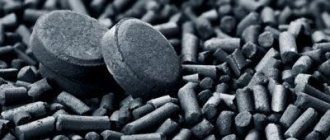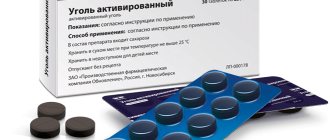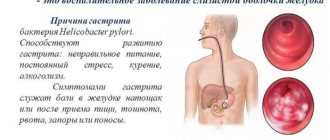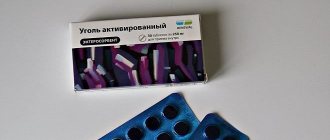Author of the article
Daria Shirochina
Practitioner. She graduated with honors from Vitebsk State Medical University in 2012 with a degree in general medicine. She was awarded a certificate of honor for her achievements in her work.
Ask a Question
Activated charcoal for heartburn is used as a temporary remedy. The drug promotes some neutralization of hydrochloric acid. This leads to easy relief of the person’s condition.
What is heartburn?
Occurs when stomach contents reflux into the esophagus. According to the physiological characteristics of the body, these two areas have different pH characteristics. In the first case it is acidic, in the second it is alkaline. Heartburn develops as follows:
- gastric juice is thrown into the esophagus or throat;
- irritation of the mucous membrane occurs;
- pain and a burning sensation are formed.
The cause of heartburn is associated with the presence of incompetence of the lower esophageal sphincter. This pathology is mediated by GERD. With pronounced errors in eating, non-compliance with the diet, it is accompanied by the development of heartburn.
To treat this condition, antisecretory and antacid drugs are used. Activated charcoal only temporarily helps reduce the feeling of pain and burning in the lower third of the esophagus.
Features of use during pregnancy
While carrying a child, women often encounter such an unpleasant phenomenon as heartburn. This condition develops due to compression of the organs of the digestive system by the uterus, which is constantly increasing in size.
The fetus grows and develops, compresses the gastrointestinal tract, and heartburn appears, which occurs before and after meals. It can be either temporary or permanent. More often it bothers women in the 2nd and 3rd trimester.
Will Activated Charcoal help get rid of heartburn?
- If you take the drug on an empty stomach, there will be no result.
- If you take the tablets immediately after a meal, you may notice an effect, but it will be weak.
During the period of bearing a child, heartburn is not associated with intoxication of the body, as well as excessive secretion of gastric juice. The sorbent will absorb negative substances and can be taken as a first aid drug. But it’s better not to do this, since the likelihood of inconspicuous symptoms disappearing is not high.
For heartburn, pregnant women are recommended other medications that neutralize gastric juice. But it is important that the drug is selected by a doctor, since many medications are prohibited for use during pregnancy.
Recommended video:
In what cases is it recommended to take it?
According to the instructions, the tablets are used to achieve a sorption and detoxification effect. Indications for use are as follows:
- dyspeptic disorders (nausea, vomiting, diarrhea);
- food infections;
- excessive secretion of hydrochloric acid;
- in order to reduce gas formation;
- poisoning with metals and drugs.
Activated carbon is also used when belching occurs. The drug helps to cope with the manifestations of heartburn, due to a slight decrease in secretion and acidity. As a result, a person feels the elimination of discomfort. Despite this, treatment should be carried out with a doctor. Since the appearance of a burning sensation after eating indicates the presence of a gastrointestinal disease, which requires serious drug therapy.
Study of the effect of different sorbents on the condition of the mucous membrane of the gastrointestinal tract
One of the leading pathogenetic syndromes that determines the severity of many diseases is intoxication syndrome. The accumulation of products of impaired metabolism in the biological environment of the body causes a toxic effect on the cardiovascular and central nervous systems, inhibits the detoxification function of the liver, and, according to a number of authors, contributes to the development of secondary metabolic immunodeficiency. The kidneys are most often damaged due to their active role in detoxification and elimination of endogenous metabolites, which in the most severe cases leads to the development of acute renal failure.
A universal direction in the treatment of patients with severe intoxication is the use of enterosorbents that have the ability to bind infectious agents and pathological metabolic products, thereby providing a detoxification effect. Adsorbent, detoxification, and antidiarrheal drugs are widely used in medical practice.
The standard requirements for sorbents are: atraumatic for the mucous membranes of the gastrointestinal tract (GIT), good evacuation from the intestines, high sorption capacity, convenient pharmaceutical form of release, absence of negative organoleptic properties.
Our study was devoted to the comparison of two tableted sorbents present on the Russian pharmaceutical market: Filtrum®-STI and activated carbon. The study was conducted to determine their effect on the gastrointestinal mucosa.
The study was carried out on white Wistar rats. 1.0 ml of diluted drugs was administered intragastrically through a tube before the morning feeding of the animals. For control, rats were used on regular food and with roughage. Experimental animals were divided into four groups (table).
Animals of the first, second and fourth (control) groups were on a normal diet, animals of the third group were supplemented with bran.
On the 10th day, the animals were sacrificed, the macroscopic picture of the mucous membrane was studied, for the presence of visible damage - swelling, hyperemia, hemorrhages. Then the small and large intestines were cut, and the mucous membrane was examined.
A series of sections were stained with hematoxylin-eosin, according to Van Gieson; neutral mucopolysaccharides were stained with the Schick reaction; acidic mucopolysaccharides were stained with Alcian blue and toluidine blue.
Group 1 results (activated carbon)
Visually, the mucous membrane of the stomach, small and large intestine looks normal without changes, but in 4 animals out of 6 (67%), when examined under a magnifying glass, hyperemia and swelling of the mucous membrane of the stomach and proximal duodenum is determined. In this case, “pieces” of coal were visible on the surface of the mucosa, which were washed off under running water.
Morphological studies in group 1: in Fig. Figure 1 shows the mucous membrane of the body of the stomach, the lamina propria of which is weakly, diffusely infiltrated with lymphocytes, plasma cells, and a slight admixture of segmented leukocytes. Severe swelling of the submucosal layer: edematous fluid pushes apart the layers of the lamina propria.
In Fig. 2 The lamina propria of the mucous membrane is weakly diffusely infiltrated with lymphocytes and plasma cells.
In Fig. Figure 3 shows the mucous membrane of the small intestine with high villi lined with goblet enterocytes. The lamina propria is moderately diffusely infiltrated with lymphocytes, plasma cells, and a significant admixture of eosinophils.
In Fig. 4, pronounced infiltration of lymphocytes and plasma cells with an admixture of eosinophils in the submucosal layer is determined.
In Fig. Figure 6 shows the mucous membrane of the colon, the lamina propria and submucosal layer of which are weakly infiltrated by lymphocytes and plasma cells with a slight admixture of eosinophils.
Results in groups 2 (Filtrum®-STI), 3 (bran) and 4 (regular diet)
Visually, the mucous membrane of the stomach, small and large intestine looks normal without changes. There is no plaque or any inclusions.
Morphological studies in groups 2, 3, 4: no microscopic changes were detected (Fig. 7, 8, 9).
In Figures 7, 8 and 9, the mucous membrane of the body of the stomach, the antrum of the stomach and the small intestine is of normal structure without inflammatory changes.
conclusions
The use of Filtrum®-STI does not cause changes in the mucous membrane of the gastrointestinal tract of rats. No damage was detected in the group of rats with a normal diet and in the group with the addition of roughage.
Morphological studies demonstrate that after ten days of taking activated carbon, chronic gastritis, jeunitis, and colitis develop in the mucous membrane of the gastrointestinal tract in animals, which can be of varying degrees of severity (active, pronounced, mild). In all cases, there is swelling of the submucosal layer, infiltration of lymphocytes, plasma cells and eosinophils. This indicates that there is an inflammatory reaction in the gastrointestinal mucosa after a ten-day administration of an activated carbon solution.
B. Z. Chikunova I. E. Trubitsyna , Doctor of Medical Sciences P. B. Novikov Central Research Institute of Gastroenterology , Moscow
Mode of application
Activated charcoal for heartburn is dosed depending on the age of the patient. In case of poisoning or intoxication, the drug is taken at the rate of 1 tablet per 10 kg of body weight. Take the medicine with plenty of water, milk, juice.
Use as follows:
- Adults up to 10 g per day.
- Children up to 5 g throughout the day.
The duration of treatment is one week. The maximum permissible period of use is 14 days.
Activated carbon should not be taken for a long period of time. Once in the intestines, it adsorbs vitamins, minerals and other beneficial substances.
Instructions for use
If an attack of heartburn develops, it is necessary to take a tablet or powder format of the product. Activated carbon packaged in hard gelatin capsules is not suitable, since it begins to act only after entering the aggressive environment of the stomach and dissolving the packaging shell.
If heartburn develops, you must simultaneously take several tablets of the drug at the rate of 1 pill per 10 kg of weight. You need to drink them with plenty of clean water.
To enhance the adsorbing effect, it is advisable to thoroughly crush the drug or use a ready-made powder format. In this case, it is diluted in water to a mushy state and taken orally with water. It can be replaced with kefir, which will only enhance the effect.
In case of severe attacks of heartburn, accompanied by pain, crushed charcoal can be mixed with milk: the drug will “collect” gastric juice, and the milk will “extinguish” the increased acidity.
Capsulated activated charcoal is not suitable for eliminating heartburn, since the shell dissolves only in the stomach
You can only use pharmacy activated carbon. It is prohibited to use a wood analog obtained by burning at the stake for heartburn. It may contain aggressive components, which will cause severe poisoning.
Method of use
Helps with heartburn within 30 minutes. Symptoms of burning and discomfort in the esophagus are reduced. There are two methods of using activated carbon:
- in the form of tablets;
- in the form of a paste.
The dose is selected taking into account age. It is recommended to take the drug immediately when heartburn symptoms appear. For a quick effect, it is suggested to make a powder (according to reviews, it works more effectively). You need to take the tablets and crush them with a hammer or spoon. Mix the resulting mixture with water or milk.
Activated charcoal is a temporary remedy for heartburn. It should be used if there are no other drugs in your home medicine cabinet.
Disadvantages of using the product
Does activated charcoal help with heartburn attacks? Yes, but it only gives a short-term effect. If the true cause of the condition is not eliminated, it will recur again and again.
The use of activated carbon helps to temporarily eliminate symptoms, but does not treat the underlying disease. Heartburn can be caused by gastritis or gastric ulcer. And in case of frequent attacks, it is necessary to obtain competent advice from a specialized specialist and undergo a comprehensive examination.
Too high doses of coal can cause disturbances in the gastrointestinal tract. This is expressed in the appearance of constipation or diarrhea.
It is also impossible to use the drug for too long, since it removes not only excess gastric juice, but also substances useful to the human body, these are vitamins, minerals, proteins, hormones and digestive enzymes, passing through the intestines like a large broom.
Against the background of such a radical cleansing, the risk of developing dysbiosis and concomitant gastrointestinal pathologies increases significantly. All this leads to a decrease in immune defense and a deterioration in metabolic processes.
Exceeding the recommended dosage of the drug may cause problems with stool
Activated carbon is not recommended to be taken simultaneously with other medications, as it reduces their effectiveness. After dissolving in the contents of the stomach, medications are simply absorbed by charcoal and excreted from the body, without having time to provide the desired therapeutic effect.
Positive sides
The sorbent is completely harmless and safe for children and adults. Allowed during pregnancy and breastfeeding. The “advantages” of activated carbon are as follows:
- does not have an irritating effect on the gastrointestinal mucosa;
- does not cause diarrhea;
- tolerated by most people.
The drug is not absorbed into the systemic bloodstream and does not affect other organs and structures. Side effects rarely occur.
The tablets turn feces black.
Effect of activated carbon on heartburn
Let us remind you why heartburn occurs - the reason for its appearance is the effect of gastric juice on the mucous membrane of the upper parts of the digestive system. First of all, hydrochloric acid, which is part of the gastric juice, has a detrimental effect on the esophagus, the pH of which, unlike the pH of the stomach, is not acidic, but alkaline. If the lower esophageal sphincter (the round muscle that closes the passage to the stomach) malfunctions, the contents of the stomach can flow back, disrupting the protection system there and injuring the esophagus.
The benefits of activated charcoal for heartburn
How does activated charcoal protect the body from burning pain? Activated carbon can be used against heartburn due to its specific structure. The drug is made from carbon-containing materials:
- charcoal or coconut charcoal;
- coal or petroleum coke.
The tablet itself has a porous structure (which significantly increases its surface area), due to which its ability to adsorb (absorb) other substances is manifested. By interacting with hydrochloric acid, activated carbon enters into a chemical reaction with it, thereby neutralizing excess acid production. The greater the amount of the drug you drink (without fanaticism, 3-4 tablets are enough), the more effective the process of getting rid of heartburn will be.
If burning pain occurs due to acute gastritis (after eating low-quality foods), charcoal is ideal to feel much better.
"Disadvantages" of use
The negative aspects of using a sorbent consist of several aspects. These include:
- Development of hypovitaminosis due to long-term use. The optimal period for therapy is 14 days. Exceeding this interval entails a decrease in the absorption of vitamins and minerals. This leads to suppressed immunity.
- Short-term effect. Activated carbon does not affect the mechanism of hydrochloric acid secretion itself. Its effect on acidity has been noted. For this reason, heartburn will appear constantly, which requires adequate therapy.
- Incompatibility with other medications. It is not recommended to take it simultaneously with other medications. This leads to a decrease in their effect.
Activated charcoal may not always help against heartburn. With strong secretion, the presence of GERD, and the absence of adequate treatment, improvement in well-being does not always occur. Therefore, all patients suffering from a constant burning sensation are advised to visit a specialist. Neglect of therapy causes the development of esophageal strictures and narrowing.
What is the drug and its effect
Activated carbon is a completely natural product made from carbon-containing substances. It is non-toxic and therefore completely safe. The drug is approved for use during pregnancy and the subsequent period of breastfeeding. Activated carbon does not have a negative effect on the developing fetus.
The principle of action of the drug is based on its porous structure. Due to this, it has high adsorbing properties, i.e., after entering the stomach and intestinal tract, the drug, like a sponge, absorbs all aggressive substances and firmly holds it inside.
Coal is a porous substance considered one of the best and safest adsorbents.
The drug is not absorbed by the walls of the gastrointestinal tract and does not cause irritation of its mucous membrane. The medication is excreted naturally 7–10 hours after administration, turning the stool dark.
The effect of taking the drug appears after it enters the esophagus. By adsorbing the gastric juice present in its lumen, charcoal reduces the symptoms of heartburn. In addition, the drug reduces acidity levels. And when gastric contents are refluxed into the esophagus again, heartburn will not be so severe.
Contraindications
Not everyone is allowed to take activated charcoal to relieve heartburn. It is strictly prohibited for persons who have:
- Ulcerative lesions of the gastrointestinal tract. There is a risk of bleeding.
- Hypersensitivity to components of tablets and other medications. May lead to severe allergies.
- Simultaneous use of antitoxic drugs. Mediated by a decrease in their therapeutic effect.
Additionally, the drug is not recommended for young children.









